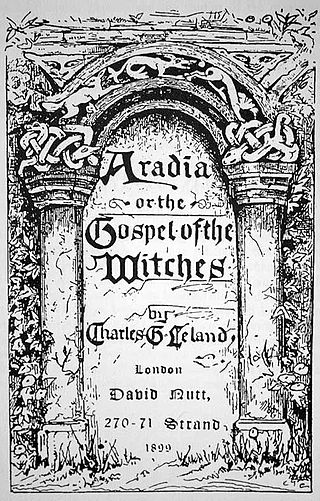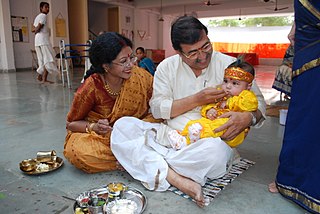
Dianic Wicca, also known as Dianic Witchcraft, is a modern pagan goddess tradition focused on female experience and empowerment. Leadership is by women, who may be ordained as priestesses, or in less formal groups that function as collectives. While some adherents identify as Wiccan, it differs from most traditions of Wicca in that only goddesses are honored.

Phillip Emmons Isaac Bonewits was an American Neo-Druid who published a number of books on the subject of Neopaganism and magic. He was a public speaker, liturgist, singer and songwriter, and founder of the Neopagan organizations Ár nDraíocht Féin and the Aquarian Anti-Defamation League. Born in Royal Oak, Michigan, Bonewits had been heavily involved in occultism since the 1960s.

Modern paganism, also known as contemporary paganism and neopaganism, is a term for a religion or family of religions influenced by the various historical pre-Christian beliefs of pre-modern peoples in Europe and adjacent areas of North Africa and the Near East. Although they share similarities, contemporary pagan movements are diverse, and do not share a single set of beliefs, practices, or texts. Scholars of religion may characterise these traditions as new religious movements. Some academics who study the phenomenon treat it as a movement that is divided into different religions while others characterize it as a single religion of which different pagan faiths are denominations.

Wicca is a modern pagan syncretic religion. Scholars of religion categorize it as both a new religious movement and as part of the occultist stream of Western esotericism. It was developed in England during the first half of the 20th century and was introduced to the public in 1954 by Gerald Gardner, a retired British civil servant. Wicca draws upon a diverse set of ancient pagan and 20th-century hermetic motifs for its theological structure and ritual practices.
Alexandrian Wicca or Alexandrian Witchcraft is a tradition of the Neopagan religion of Wicca, founded by Alex Sanders who, with his wife Maxine Sanders, established the tradition in the United Kingdom in the 1960s. Alexandrian Wicca is similar in many ways to Gardnerian Wicca, and receives regular mention in books on Wicca as one of the religion's most widely recognized traditions.

Ár nDraíocht Féin: A Druid Fellowship, Inc. is a non-profit religious organization dedicated to the study and further development of modern Druidry.
In the study of religion, orthopraxy is correct conduct, both ethical and liturgical, as opposed to faith or grace. Orthopraxy is in contrast with orthodoxy, which emphasizes correct belief. The word is a neoclassical compound—ὀρθοπραξία meaning 'right practice'.
Odyssean Wicca is a Wiccan tradition created in Toronto, Ontario, Canada in the late 1970s. Its principal founders were Tamarra and Richard James. Most of its practitioners today live in Ontario, but it also has members in Eastern Canada and the United States. The tradition differs from other initiatory Wiccan traditions in its emphasis on preparation of its members for public priesthood.

The first haircut for a human has special significance in certain cultures and religions. It can be considered a rite of passage or a milestone.
A covenstead is a meeting place of a coven. The term relates specifically to the meeting place of witches within certain modern religious movements such as Wicca that fall under the collective term Modern Paganism, also referred to as Contemporary Paganism or Neopaganism. It functions to provide a place for the group to conduct rituals, undertake lessons and recognise festivals. It can also be referred to as the home of the coven.

Aradia, or the Gospel of the Witches is a book composed by the American folklorist Charles Godfrey Leland that was published in 1899. It contains what he believed was the religious text of a group of pagan witches in Tuscany, Italy that documented their beliefs and rituals, although various historians and folklorists have disputed the existence of such a group. In the 20th century, the book was very influential in the development of the contemporary Pagan religion of Wicca.
Drawing down the Moon is a central ritual in many contemporary Wiccan traditions. During the ritual, a coven's High Priestess enters a trance and requests that the Goddess or Triple Goddess, symbolized by the Moon, enter her body and speak through her. The High Priestess may be aided by the High Priest, who invokes the spirit of the Goddess. During her trance, the Goddess is supposed to speak through the High Priestess.

Polytheistic reconstructionism is an approach to modern paganism first emerging in the late 1960s to early 1970s, which gathered momentum starting in the 1990s. Reconstructionism attempts to re-establish genuine polytheistic religions in the modern world through a rediscovery of the rituals, practices and contextual worldviews of pre-Christian Pagan religions. This method stands in contrast with other neopagan syncretic movements like Wicca, and ecstatic/esoteric movements like Germanic mysticism or Theosophy.

Samskara are sacraments in Hinduism and other Indian religions, described in ancient Sanskrit texts, as well as a concept in the karma theory of Indian philosophies. The word literally means "putting together, making perfect, getting ready, to prepare", or "a sacred or sanctifying ceremony" in ancient Sanskrit and Pali texts of India.
Hollekreisch, sometimes referred to as “Hoolegrasch” or “Hallekreisch”, is a birth ritual practiced by Ashkenazi Jews. It pertains to the naming of sons and daughters and is a ceremony practiced by children. The name given in this ceremony is not the sacred Hebrew name, but the name used in every-day life. The ceremony first appeared in the Middle Ages in the regions of Alsace, Southern Germany and Switzerland and is still practiced in certain parts of Switzerland and Alsace, despite the initial belief that it had disappeared.

A naming ceremony is a stage at which a person or persons is officially assigned a name. The methods of the practice differ over cultures and religions. The timing at which a name is assigned can vary from some days after birth to several months or many years.
Modern paganism in the United States is represented by widely different movements and organizations. The largest modern pagan religious movement is Wicca, followed by Neodruidism. Both of these religions or spiritual paths were introduced during the 1950s and 1960s from Great Britain. Germanic Neopaganism and Kemetism appeared in the US in the early 1970s. Hellenic Neopaganism appeared in the 1990s.

Druidry, sometimes termed Druidism, is a modern spiritual or religious movement that promotes the cultivation of honorable relationships with the physical landscapes, flora, fauna, and diverse peoples of the world, as well as with nature deities, and spirits of nature and place. Theological beliefs among modern Druids are diverse; however, all modern Druids venerate the divine essence of nature.

Koliada or Koleda is a Slavic mythological deity, that personalizes the newborn winter infant Sun and impersonates the New Year's cycle. It is connected with the solar cycle, passing through the four seasons and from one substantial condition into another.

Modern paganviews on LGBT people vary considerably among different paths, sects, and belief systems. LGBT individuals comprise a much larger percentage of the population in neopagan circles than larger, mainstream religious populations. There are some popular neopagan traditions which have beliefs often in conflict with the LGBT community, and there are also traditions accepting of, created by, or led by LGBT individuals. The majority of conflicts concern heteronormativity and cisnormativity.














